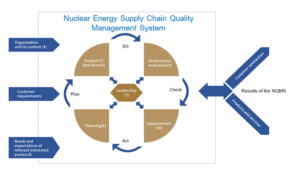What is ISO 19443
ISO 19443 is a system that covers systematic methodologies and procedures for the effective quality management of the nuclear supply chain at nuclear power plants, nuclear infrastructure facilities and nuclear power producers. Based on ISO 9001, ISO 19443 adds 'nuclear safety culture' and 'nuclear quality assurance programme requirement' is an international ITNS certification that is critical for nuclear safety service providers to assess whether they are meeting quality, reliability and operating effectively.
※ Nuclear safety: the achievement of appropriate operating conditions, the prevention of accidents and the mitigation of the consequences of accidents, resulting in the protection of workers, the public and the environment from excessive radiation hazards.
※ ITNS (important for nuclear safety): the characteristics of a product, service, object or activity, the failure of which may result in excessive radiation exposure to humans or the environment.
# Main requirements of ISO 19443
- Nuclear safety culture: Nuclear safety culture refers to the accumulation of characteristics and attitudes of an organisation or individual that considers nuclear safety as a top priority and makes decisions by following the relevant regulations and considering nuclear safety as a top priority. It stipulates that the performance of work should be recognised as core values and behaviours.
- Identification of ITNS positions and activities: It is required to identify the characteristics of products, services, objects or activities whose failure could expose people or the environment to excessive radiation and to take preventive action in advance.
- A graded approach: method used to ensure that quality control, documentation, monitoring and measurement requirements are appropriate to the materiality of nuclear safety, and requires that the associated requirements are managed through classification.
- Commercial grade product or activity: It is an item (see paragraph 3.6) or activity (see paragraph 3.1) that has an impact on nuclear safety and that has not been designed, manufactured or constructed in accordance with the specified requirements for nuclear material.
- Counterfeit/fraudulent/suspect product (CFS): If CFS elements are detected, they should be treated as non-compliance and stakeholders, including the customer, should be informed immediately.

Benefits of ISO 19443
- Quality improvement: ISO 19443 improves the quality of products, services and processes. Advanced quality control procedures reduce product defects and increase customer satisfaction.
- Improving safety and reliability: ISO 19443 contributes to strengthening the nuclear safety culture and increasing the reliability of nuclear power plants. Reduce the likelihood of accidents and disasters through compliance with safety-related requirements and appropriate risk management.
- Prevention of counterfeit, fraudulent or suspect products (CFS): Establish ISO 19443 to transparently disclose the origin and manufacturer of products and improve supplier verification and monitoring to prevent suspect products. 19443 helps organisations strengthen preparedness and maintain quality and safety against counterfeiting, fraud and suspicious items, and provides consumers with safe and reliable products.
- Strengthening regulation and compliance: The nuclear industry is tightly regulated and compliance with safety and quality regulations is crucial. ISO 19443 reinforces compliance with relevant laws and regulations, thereby helping an organisation to remain compliant.
- Greater customer satisfaction: As quality improves, the satisfaction of customers, users and related stakeholders improves. Safe and reliable operation of nuclear power plants builds customer confidence.
- Drive a culture of continuous improvement: A quality management system promotes continuous improvement in an organisation. Continuously improve your organisation's capabilities and performance by using data and feedback to improve processes and solve problems.
Presentation of the structure of ISO 19443:2018 in the PDCA cycle
ISO 19443:2018 requirements
| 4 Context of the organisation | |
| 4.1 | Understanding the organisation and its context |
| 4.2 | Understanding the needs and expectations of stakeholders |
| 4.3 | Definition of the scope of the quality management system |
| 4.4 | Quality management system and its processes |
| 5 Leadership | |
| 5.1 | Leadership and commitment. |
| 5.1.1 | General |
| 5.1.2 | Customer focus |
| 5.1.3 | Nuclear safety culture |
| 5.2 | Policy |
| 5.2.1 | Establishing a quality policy |
| 5.2.2 | Communication of quality policy |
| 5.3 | Organisational roles, responsibilities and powers |
| 6. Planning | |
| 6.1 | Actions to counter threats and opportunities |
| 6.1.3 | Identification of ITNS positions and activities |
| 6.1.4 | A step-by-step approach to applying quality requirements |
| 6.2 | Quality objectives and planning to achieve them |
| 6.3 | Planning for change |
| 7 Support | |
| 7.1 | General |
| 7.1.2 | People |
| 7.1.3 | Infrastructure |
| 7.1.4 | Process environment |
| 7.1.5 | Monitoring and measuring resources |
| 7.1.6 | Organisational knowledge |
| 7.2 | Competence |
| 7.3 | Awareness |
| 7.4 | Communication |
| 7.5 | Documented information |
| 7.5.2 | Creation and updating |
| 7.5.3 | Control of documented information |
| 8 Action | |
| 8.1 | Operational planning and control |
| 8.1.1 | Regulations on counterfeit, fraudulent or suspect products (CFS) |
| 8.2 | Product and service requirements |
| 8.2.1 | Communication with the customer |
| 8.2.2 | Definition of product and service requirements |
| 8.2.3 | Overview of product and service requirements |
| 8.2.4 | Changes in product and service requirements |
| 8.3 | Design and development of products and services |
| 8.3.2 | Design and development planning |
| 8.3.3 | Design and development inputs |
| 8.3.4 | Design and development controls |
| 8.3.4.1 | Design and development, verification and validation testing |
| 8.3.5 | Design and development results |
| 8.3.6 | Design and development changes |
| 8.4 | Control of externally supplied processes, products and services |
| 8.4.1 | General |
| 8.4.2 | Type and scope of controls |
| 8.4.3 | Information for external suppliers |
| 8.5 | Production and provision of services |
| 8.5.1 | Control of production and service provision |
| 8.5.1.1 | Control of production equipment |
| 8.5.1.2 | Monitoring and measurement activities |
| 8.5.2 | Identification and traceability |
| 8.5.3 | Property belonging to customers or external suppliers |
| 8.5.4 | Maintenance |
| 8.5.5 | Post-delivery activities |
| 8.5.6 | Change control |
| 8.6 | Marketing of products and services |
| 8.7 | Control of incompatible outputs |
| 9. performance evaluation | |
| 9.1 | Monitoring, measurement, analysis and evaluation |
| 9.1.2 | Customer satisfaction |
| 9.1.3 | Analysis and evaluation |
| 9.2 | Internal audit |
| 9.3 | Management review |
| 9.3.2 | Management review input data |
| 9.3.3 | Results of the management review |
| 10. improving | |
| 10.1 | General |
| 10.2 | Non-compliance and corrective action |
| 10.3 | Continuous improvement |

